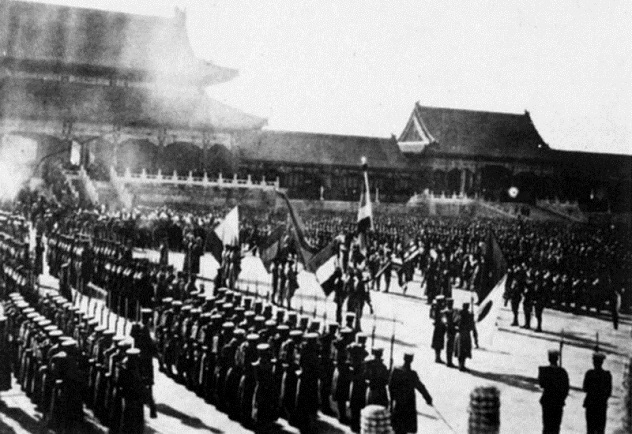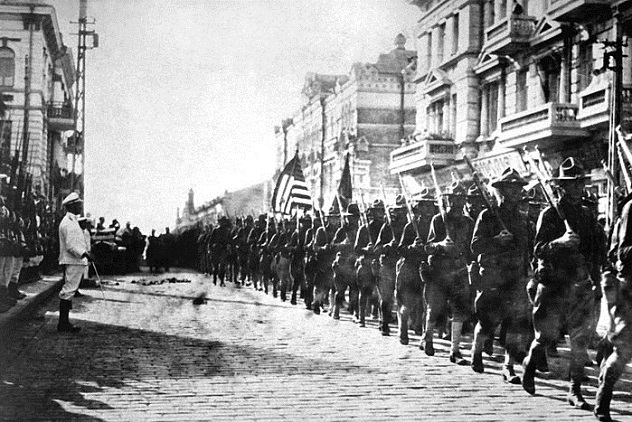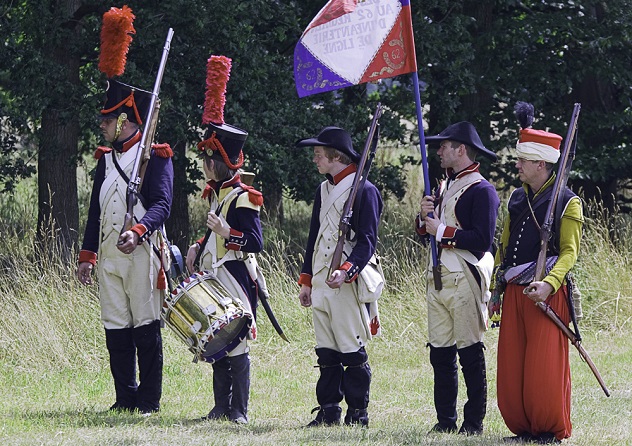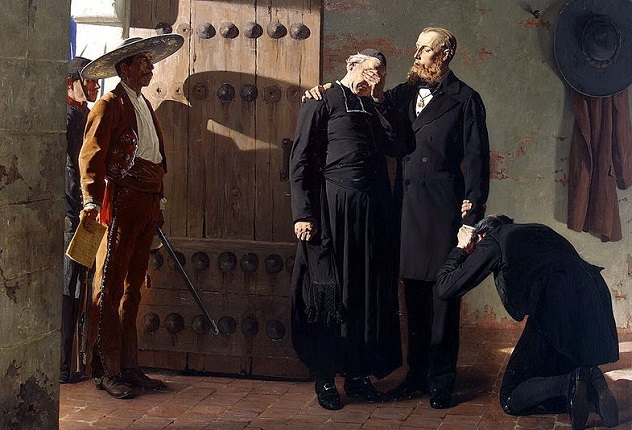 Travel
Travel  Travel
Travel  Creepy
Creepy 10 Haunted Places in Alabama
 History
History Top 10 Tragic Facts about England’s 9 Days Queen
 Food
Food 10 Weird Foods Inspired by Your Favorite Movies
 Religion
Religion 10 Mind-Blowing Claims and Messages Hidden in the Bible Code
 Facts
Facts 10 Things You Never Knew about the History of Gambling
 Weird Stuff
Weird Stuff 10 Cool and Creepy Facts about Collecting Tears
 Humans
Humans The Ten Most Lethal Gunslingers of the Old West
 Misconceptions
Misconceptions 10 Phony Myths and Urban Legends That Just Won’t Die
 History
History 10 Amazing Roman Epitaphs
 Travel
Travel Top 10 Religious Architectural Marvels
 Creepy
Creepy 10 Haunted Places in Alabama
 History
History Top 10 Tragic Facts about England’s 9 Days Queen
Who's Behind Listverse?

Jamie Frater
Head Editor
Jamie founded Listverse due to an insatiable desire to share fascinating, obscure, and bizarre facts. He has been a guest speaker on numerous national radio and television stations and is a five time published author.
More About Us Food
Food 10 Weird Foods Inspired by Your Favorite Movies
 Religion
Religion 10 Mind-Blowing Claims and Messages Hidden in the Bible Code
 Facts
Facts 10 Things You Never Knew about the History of Gambling
 Weird Stuff
Weird Stuff 10 Cool and Creepy Facts about Collecting Tears
 Humans
Humans The Ten Most Lethal Gunslingers of the Old West
 Misconceptions
Misconceptions 10 Phony Myths and Urban Legends That Just Won’t Die
 History
History 10 Amazing Roman Epitaphs
10 Absurdly Out-Of-Place Soldiers
There are many reasons to go to war, but it is generally in support of the country’s best interests. Sometimes, however, a soldier will find himself on the other side of the world, fighting for reasons that aren’t apparent. They—and we—are left to puzzle over the absurdity of the following military deployments.
10The Norwegian Crusade

The Crusades drew people across vast distances in the name of their faith, but perhaps the most extreme case was King Sigrid (who was appropriately called “The Crusader”) of Norway. After setting out in 1107, they spent one winter in England, one in Galicia, and one in Sicily. Along the way, they even battled Muslim pirates in Spain.
After all this trouble, Sigurd spent less than a year in the Holy Land, though he was busy in that time. He was baptized in the Jordan River and integral to the capture of Sidon, receiving a piece of the True Cross for his efforts. He then turned around and went home. Of course, there were still more stops along the way, including Cyprus, Greece, Constantinople, and even the court of the Holy Roman Emperor. All in all, Sigurd spent seven years on campaign, six of them traveling.
9Spanish Mercenaries Form A Greek State

The Catalan Company of northeastern Spain was originally formed to fight in the War of the Sicilian Vespers. When that conflict ended in 1302, they went east to aid the ailing Byzantine Empire against the Ottoman Turks. Their service there consisted of fighting Genoans in Constantinople and Alanian mercenaries also serving the Byzantines before recruiting Turkish horsemen and raiding the Aegean coast. The Byzantines were not pleased, to say the least, and wiped out a large part of the company in an ambush before pursuing them for the next five years.
In 1310, they accepted work from the Duke of Athens, Walter de Brienne. When he tried to worm his way out of paying them, they revolted. The duke and most of his knights were slaughtered after charging unknowingly into a flooded field, and the Catalans became rulers of the Duchy of Athens. They maintained control for 80 years, theoretically as part of Aragon, but the turmoil had caused the duchy’s weaving-based economy to collapse. Their last stronghold, Athens itself, fell in 1388 to the Navarrese Company.
8Everyone Goes To China

The Boxer Rebellion in China arose from a century of humiliation by the West. The 19th century had seen Britain declare two Opium Wars, France supplant them in northern Vietnam, and Japan swoop in to take Taiwan as well as suzerainty of Korea. The Boxer Rebellion, so called because its adherents believed boxing rituals made them bulletproof (spoiler: it didn’t), was the result of the inevitable anti-Western backlash.
Beginning with attacks against Chinese Christians, the rebels besieged the foreign legation district in Peking in June 1900, killing the German minister. Empress Dowager Cixi lent support to their actions, ensuring the need for foreign intervention. A slapdash force of 2,100 men was thrown together, mostly sailors and marines from the US, Germany, Russia, France, Japan, Italy, Austria, and Britain.
This ad hoc force was handily driven back, however, and it eventually took a force of 20,000 to break through to Peking and relieve the two-month siege of the legation district, forcing $330 million in reparations upon the Qing. A 550-man Australian contingent was also sent but arrived too late for the fighting. Its contribution consisted of collecting a fine, burning down a temple, and executing Chinese rebels caught attacking Western people or property.
7Napoleonic Officers Train The Sikh Army

The end of the Napoleonic Wars left many French officers out of a job, and remaining in France wasn’t an attractive prospect to a loyal Bonapartist soldier. Enter Maharaja Ranjit Singh, ruler of a Sikh state centered on Lahore (currently situated just on the Pakistani side of the Indian border), nicknamed “The Lion of the Punjab.”
Singh had watched as British control of India crept toward his southern frontier and knew his army was no match, so he jumped at the opportunity provided by the arrival of two French soldiers at his court in 1822, who came to lead the formidable Fauj-i-Khas. A slew of others followed in their wake, including Prussians, Spaniards, Netherlanders, and Italians, who were quickly employed in several regiments and as civil administrators.
By the end of his reign in 1839, Singh employed 39 European officers and a standing army of 50,000 men. The British had been watching him closely, maintaining a shaky alliance until Singh died, when they took advantage of the chaos into which the state had descended and swooped in. Following a brutal four-year war, the British emerged victorious.
6Two Romans In Sudan

For a long time, the source of the Nile River was a mystery to Europeans, only coming to light fully in the 19th century. One of those intrigued by the river was the Roman emperor Nero, best known for not actually fiddling while Rome burned. In A.D. 62, he sent an expedition to explore the river. There were two primary motivations for such an exploration: answering the questions posed by Greek geographers about the flooding of the Nile, and gathering information for potential trade or conquest.
The expedition consisted of two centurions, who struck out from the Roman vassal state of Meroe, located 200 kilometers (120 mi) northeast of the modern Sudanese capital of Khartoum. With the help of the Meroitic people, these two men traveled south in a futile attempt to penetrate the mighty Sudd swamp. Beset by disease and floundering in the mud and entangling plants, the centurions gave up. They reached the conclusion that the marsh was so immense that “neither the inhabitants know, nor can anyone hope to know” its extent.
5Cubans In Angola

Angola had a traumatic 20th century, with 40 years of intermittent warfare, first against the Portuguese for independence and then between rivaling factions from 1961–2002. As this was the Cold War era, the civil conflict was quickly delineated between a communist People’s Movement for the Liberation of Angola (MPLA) and an anti-communist National Union for the Total Independence of Angola (UNITA).
When Portugal pulled out in 1974, US-backed South Africa intervened in an attempt to keep the MPLA from achieving power. They were initially driven back before launching a conventional invasion in 1980 with the help of a more cooperative Republican White House. Cuba upped the ante by deploying 15,000 troops in 1975 to fight South Africa for their communist brothers, and a decade of stalemate followed. A series of offensives in 1985–87 failed to gain much, even when Cuba took over the planning and increased its commitment to 50,000.
However, the Cubans were unwilling to press on into Namibia, and South Africa faced growing discontent at home. As such, a negotiated settlement was reached, after which Cuba withdrew from Angola, and South Africa released Namibia to independence.
4Allied Intervention In The Russian Civil War

Tsarist rule collapsed under the pressures of World War I in 1917, which saw the Lenin-led Bolsheviks seize power and sign the Treaty of Brest-Litovsk with Germany before descending into civil war between the Bolshevik “reds” and the loosely aligned anti-Bolshevik “whites.” This caused great consternation in the other Allied powers, who started planning an intervention to reopen the Western front. Germany’s defeat in 1918 rendered this objective moot, but they intervened anyway, partially out of loyalty to their exiled Russian allies and partly for fear of communism.
A French force landed in Ukraine but threw up their hands in confusion at the mix of reds, whites, and Ukrainian nationalists, withdrawing after scarcely any combat. The British dawdled about in the North, achieving little and diverting funds from important post-war reconstruction projects. Most interesting, however, is the 60,000-strong Czech Legion, made up of Austro-Hungarian prisoners who defected to Russia and were granted safe passage to join the Allies in France. Since Russia’s European ports were not secure, they had to travel across the country to Vladivostok on the Pacific coast.
Unfortunately, tensions with the Bolsheviks exploded into open conflict, after which the Czechs seized control of all major Siberian cities, including Vladivostok. By this time, World War I had ended, resulting in the Czechs fighting alongside Japan, France, and Britain in eastern Russia. Eventually, they cut a deal and returned to Czechoslovakia to form a major part of that country’s army.
3The Polish Fought For The Haitian Slave Revolt

History has been harsh on Poland, especially in the late 18th century, when their country was carved up by Prussia, Russia, and Austria. Many were forced to flee, some of whom eventually found their way into service in the French Army’s Polish Legion, as Revolutionary France had proclaimed equality for all men and campaigned against Poland’s occupiers.
Then, a slave revolt rocked the French colony of St. Dominique, which is now Haiti. While a diplomatic solution was originally reached with Haitian leader Toussaint Louverture, Napoleon felt the need to restore French prestige and reinstate the old order with military force. In 1802, he sent an army under his brother-in-law General Leclerc, which included the Polish Legion, now numbering 5,000. The campaign was a disaster, with many of the troops dying of yellow fever and the rest struggling to deal with guerrilla warfare tactics, especially in the island’s mountainous interior.
The Polish soon fell into disrepute with their French commanders for their supposed unsuitability for jungle warfare. They wilted under the heat and suffered a surfeit of other maladies associated with the consumption of unripe fruit and assorted parasites and insects. As they grew increasingly dissatisfied with French atrocities, they came to sympathize with the cause of the slaves, an oppressed people not unlike their own. Many of them defected, especially when Britain rejoined the war.
After the French defeat, only around 400 members of the Legion remained on the island. Some Haitians in the region of Cazale still claim Polish ancestry. The overwhelming majority of the rest of the Legion were dead, mostly of yellow fever, while a few hundred enlisted with the British and a handful of officers emigrated to the United States.
2Napoleon’s Mamluks

The Mamluks were originally a caste of slave soldiers recruited by Egyptian sultans in the Middle Ages, but eventually, they rid themselves of the sultan to become the new ruling class. They were an intimidating foe, expert horsemen who charged their enemies headlong while firing pistols and carbines wildly, hurling javelins, and closing to engage with their curved sabers.
Unfortunately, these tactics couldn’t overpower the disciplined, modern army Napoleon brought on his ill-advised invasion of Egypt in 1798 (though one Mamluk supposedly sliced through a musket), and they were defeated at the Battle of the Pyramids. However, their bravery impressed their opponent, and a small number—no more than 100—were recruited into Napoleon’s personal bodyguard.
The flamboyant former Egyptian slaves—bedecked in turbans, embroidered vests, and silk shirts—served Napoleon in campaigns across Europe, with a small contingent remaining in Waterloo. They were a beacon of loyalty, with one suffering 40 wounds fighting for his leader. A group of Mamluks even saved Napoleon from being cut off by Cossacks during the emperor’s other ill-advised venture, the Russian campaign. Following Napoleon’s deposition, many of the few surviving Mamluks were murdered by vengeful royalists.
1Egyptians Fight For France In Mexico (To Build An Austrian Emperor)

Napoleon III embarked upon even more ill-advised missions than his uncle, and the invasion of Mexico in 1863 was undoubtedly one of them. Napoleon charged in after Mexico suspended their interest payments, and Austrian Archduke Maximilian eventually tagged along, briefly becoming emperor of Mexico. They were initially supported by Britain and Spain, who withdrew when the scope of Napoleon’s ambition (that is, taking all of Mexico) became clear.
Napoleon did, however, retain support from Egypt. The country was largely economically dependent on France and Britain, so they were obliged to assist the Mexican campaign. They sent a battalion of Egyptian officers and Sudanese troops, who were said to be immune to the heat and disease of Mexico. However, Napoleon’s whole enterprise fell apart when newly reunified America got involved, after which the French and their Egyptian battalion withdrew. Emperor Max was left behind and executed by firing squad.
Tyler is a miserable creature who lives the life of a degenerate loafer. Writing is one of the few mildly constructive activities he engages in. Should you feel the need to spew vitriol at him, you can do so here or here. He can also be found throwing words at our sister site, KnowledgeNuts.








